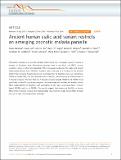| dc.contributor.author | Dankwa, Selasi | |
| dc.contributor.author | Lim, Caeul | |
| dc.contributor.author | Bei, Amy K. | |
| dc.contributor.author | Jiang, Rays H. Y. | |
| dc.contributor.author | Abshire, James Robbins | |
| dc.contributor.author | Patel, Saurabh D. | |
| dc.contributor.author | Goldberg, Jonathan M. | |
| dc.contributor.author | Moreno, Yovany | |
| dc.contributor.author | Kono, Maya | |
| dc.contributor.author | Niles, Jacquin C. | |
| dc.contributor.author | Duraisingh, Manoj T. | |
| dc.date.accessioned | 2016-06-16T19:27:14Z | |
| dc.date.available | 2016-06-16T19:27:14Z | |
| dc.date.issued | 2016-04 | |
| dc.date.submitted | 2015-08 | |
| dc.identifier.issn | 2041-1723 | |
| dc.identifier.uri | http://hdl.handle.net/1721.1/103124 | |
| dc.description.abstract | Plasmodium knowlesi is a zoonotic parasite transmitted from macaques causing malaria in humans in Southeast Asia. Plasmodium parasites bind to red blood cell (RBC) surface receptors, many of which are sialylated. While macaques synthesize the sialic acid variant N-glycolylneuraminic acid (Neu5Gc), humans cannot because of a mutation in the enzyme CMAH that converts N-acetylneuraminic acid (Neu5Ac) to Neu5Gc. Here we reconstitute CMAH in human RBCs for the reintroduction of Neu5Gc, which results in enhancement of P. knowlesi invasion. We show that two P. knowlesi invasion ligands, PkDBPβ and PkDBPγ, bind specifically to Neu5Gc-containing receptors. A human-adapted P. knowlesi line invades human RBCs independently of Neu5Gc, with duplication of the sialic acid-independent invasion ligand, PkDBPα and loss of PkDBPγ. Our results suggest that absence of Neu5Gc on human RBCs limits P. knowlesi invasion, but that parasites may evolve to invade human RBCs through the use of sialic acid-independent pathways. | en_US |
| dc.description.sponsorship | National Institutes of Health (U.S.) (grant AI091787) | en_US |
| dc.description.sponsorship | Centers for Disease Control and Prevention (U.S.) (grant (R36-CK000119-01)) | en_US |
| dc.description.sponsorship | National Institutes of Health (U.S.) (Epidemiology of Infectious Disease and Biodefense Training Grant, 2-T32-AI007535-12) | en_US |
| dc.language.iso | en_US | |
| dc.publisher | Springer Nature | en_US |
| dc.relation.isversionof | http://dx.doi.org/10.1038/ncomms11187 | en_US |
| dc.rights | Creative Commons Attribution | en_US |
| dc.rights.uri | http://creativecommons.org/licenses/by/4.0/ | en_US |
| dc.source | Nature Publishing Group | en_US |
| dc.title | Ancient human sialic acid variant restricts an emerging zoonotic malaria parasite | en_US |
| dc.type | Article | en_US |
| dc.identifier.citation | Dankwa, Selasi, Caeul Lim, Amy K. Bei, Rays H. Y. Jiang, James R. Abshire, Saurabh D. Patel, Jonathan M. Goldberg, et al. “Ancient Human Sialic Acid Variant Restricts an Emerging Zoonotic Malaria Parasite.” Nat Comms 7 (April 4, 2016): 11187. | en_US |
| dc.contributor.department | Massachusetts Institute of Technology. Department of Biological Engineering | en_US |
| dc.contributor.mitauthor | Abshire, James Robbins | en_US |
| dc.contributor.mitauthor | Niles, Jacquin C. | en_US |
| dc.relation.journal | Nature Communications | en_US |
| dc.eprint.version | Final published version | en_US |
| dc.type.uri | http://purl.org/eprint/type/JournalArticle | en_US |
| eprint.status | http://purl.org/eprint/status/PeerReviewed | en_US |
| dspace.orderedauthors | Dankwa, Selasi; Lim, Caeul; Bei, Amy K.; Jiang, Rays H. Y.; Abshire, James R.; Patel, Saurabh D.; Goldberg, Jonathan M.; Moreno, Yovany; Kono, Maya; Niles, Jacquin C.; Duraisingh, Manoj T. | en_US |
| dspace.embargo.terms | N | en_US |
| dc.identifier.orcid | https://orcid.org/0000-0002-6250-8796 | |
| mit.license | OPEN_ACCESS_POLICY | en_US |
